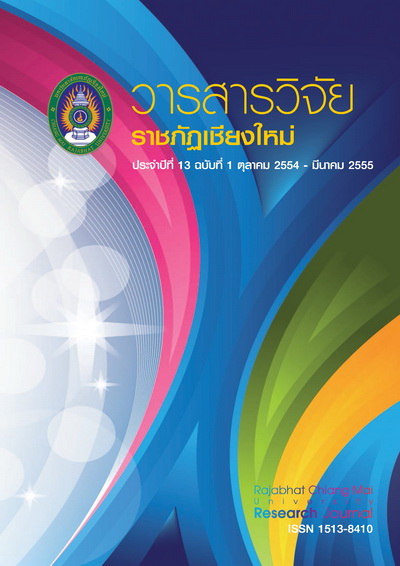ผลของโปรแกรมสุขศึกษาที่มีต่อการพัฒนาพฤติกรรม สุขภาพของเด็กวัยเรียนธาลัสซีเมีย
DOI:
https://doi.org/10.14456/rcmrj.2012.96107Abstract
การวิจัยครั้งนี้มีวัตถุประสงค์เพื่อศึกษาผลของโปรแกรมสุขศึกษาที่มีต่อการพัฒนาพฤติกรรมสุขภาพของเด็กวัยเรียนธาลัสซีเมีย กลุ่มตัวอย่างเป็นผู้ป่วยเด็กวัยเรียนธาลัสซีเมียซึ่งมีอายุระหว่าง 6-12 ปีที่มารับการตรวจรักษาในโรงพยาบาลสันป่าตอง อำเภอสันป่าตอง จังหวัดเชียงใหม่ ในช่วงเดือนมกราคมถึงเมษายน2554 โดยมีคุณสมบัติตามเกณฑ์ที่กำหนดไว้จำนวน 20 คน เครื่องมีอที่ใช้ประกอบด้วยโปรแกรมการให้สุขศึกษาเรื่องโรคธาสัสซีเมีย และวิธีการปฏิบัติตัว วิเคราะห์ขอมูลโดยการหาค่าความถี่ ค่าร้อยละ ค่าเฉลี่ย ค่าเบี่ยงเบนมาตรฐาน และเปรียบเทียบสมมติฐานด้วยการทดสอบหาค่าที ผลการวิจัยพบว่า คะแนนการรับรู้ความสามารถของตนเอง การปฎิบัติพฤติกรรมสุขภาพ และความคาดหวังในผลลัพธ์การกระทำของผู้ป่วยเด็กวัยเรียนธาสัสซีเมีย ภายหลังการให์โปรแกรมสุขศึกษาอย่างน้อย 2 สัปดาห์เพิ่มขึ้นกว่าก่อนการสอนอย่างมีนัยสำคัญทางสถิติที่ระดับ .01 คะแนนความรู้เรื่องโรคธาสัสซีเมียและการปฏิบัติตัวที่ถูกต้องของเด็กวัยเรียนธาสัสซีเมียหลังการให้สุขศึกษาทันที และภายหลังการให์โปรแกรมสุขศึกษาอย่างน้อย 2 สัปดาห์เพิ่มขึ้น โดยที่กล่มตัวอย่างที่เป็น a-Thalassemia กับ B-Thalassemia มีความรู้เรื่องโรคธาสัสซีเมีย และการปฏิบัติตัวที่ถูกต้องที่ไม่แตกต่างกัน
The Effects of the Health Education Program on Health Behavior Development of Thalassemia Children
This research was to study the result of the health education program on health behavior of schoolage children with thalassemia. The samples were 20 school-age thalassemia children between the ages of 6 and 12, treated at San Pa Tong Hospital, Chiang Mai, between January and April 2011. Methods used in this study included the health education program for thalassemia and practice. The data was gathered and analyzed by applying percentage, standard deviation, and t-test. The results were as follows: 1) The perception of self-capability and health behavior of school-age children with thalassemia and the knowledge of thalassemia and practice of school-age children with thalassemia after immediately providing the health education program and after providing the health education program for at least 2 weeks was higher than in the past at the statistically significant level of .01 2) The knowledge of thalassemia and health behavior of school-age children with thalassemia, both a-Thalassemia and p-Thalassemia, had no difference in averages. Thus, it could be concluded that the samples of a-Thalassemia and p-Thalassemia had no difference in knowledge of thalassemia and health behavior.
Downloads
Downloads
How to Cite
Issue
Section
License
1. Articles, information, content, images, etc published in the “Community and Social Development Journal” are copyrighted by the Community and Social Development Journal, Chiang Mai Rajabhat University. In order to properly distribute the articles through print and electronic media, the authors still hold the copyright for the published articles under the Creative Commons Attribution (CC BY) license, which allows the re-distribution of the articles in other sources. References must be made to the articles in the journal. The authors are responsible for requesting permission to reproduce copyrighted content from other sources.
2. The content of the articles appearing in the journal is the direct responsibility of the article authors. The editorial board of the journal does not necessarily agree with or share any responsibility.














